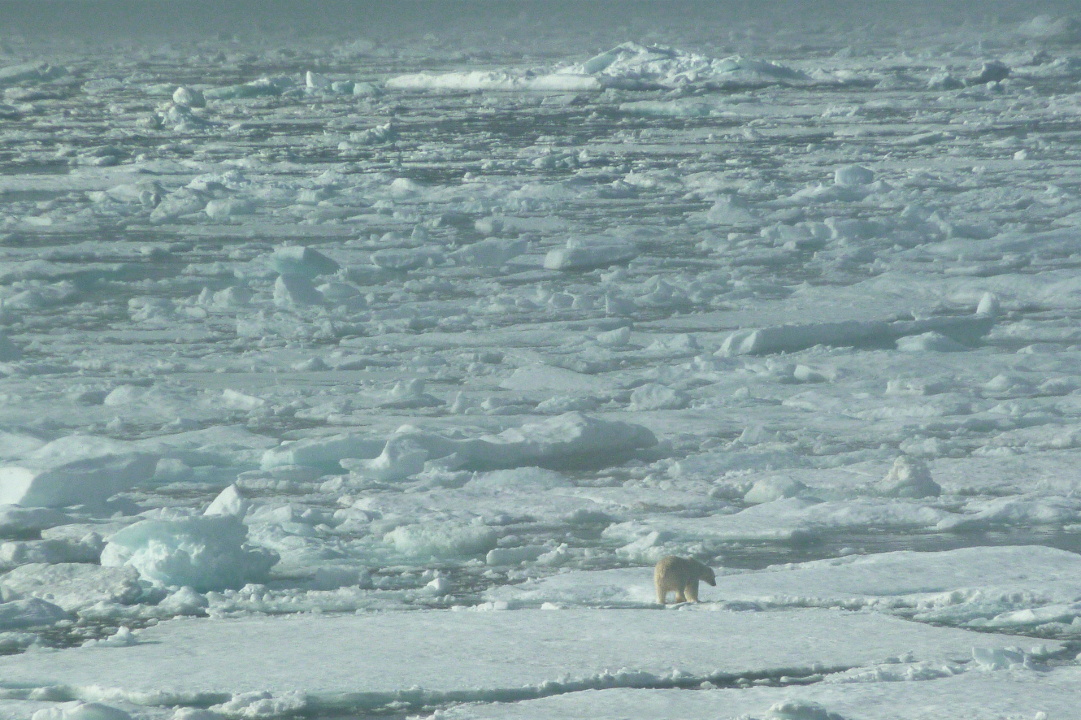I took this photo with the sun behind me. There is still plenty of haze above the water/ice.
This one, through a bridge window, looks more into the sun, with a completely different result.
Why are we up before breakfast? Bears, of course. Here, a swimming bear.
After a few minutes he reached the denser ice and hauled out.
He began to walk away from us, and eventually faded into the haze.
The beginning of this video shows how difficult it can be to pick out a polar bear amongst all the ice, especially with haze. Also intriguing is how the ice tilts and lifts up and down on the ocean swells. The polar bear is perhaps a quarter down from the top and just a bit left of center. When zooming in I almost lost him more than once, because it was impossible to see the bear on the LCD screen of my point-and-shoot camera. At full zoom I finally locate him and center the image.
This next photo is not of the same bear; it was taken 50 minutes later. This bear is approaching us.
Within five minutes he's considerably closer.
Then he reaches the edge of his comfort zone and pauses, not knowing what we are. My, what big feet you have!
Can you guess which side of the ship the bear is on?
Summoning more courage, this bear draws even closer.
After a few minutes more, he's within a few yards of the bow. He's further away vertically, because of the height of the Explorer, than he is horizontally.
Here's another look, from a slightly different angle. Love those feet.
Eventually, he decided to leave, gradually. He would meander away, then turn and look at us yet again and sniff the air, then meander further away. Look at the long neck ... all the better to swim and to grab seals from their breathing holes.
After this first flurry of polar bears, the spotting scope was deserted for a moment.
Our next discovery this morning was a polar bear lounging on a small chunk of ice. We drifted slowly towards him, but I'll spare you the approach shots.
Nearby, among all the common gulls, was a seldom-seen ivory gull. These birds rarely travel beyond the pack ice; this one is the little guy on the left. This is another case where binoculars are essential to appreciation of what you're seeing.
An Environment Canada ice chart depicts many kinds of information, through colors and by the Egg Code. It includes the percentage of sea surface covered by ice, the age of the ice (first year? multi-year?), the size of the ice, and more.
Before 11:00 another polar bear, intensely curious, swam very close to the ship, keeping an eye on us. In this video, you can see that the bears swim with only their front legs; the hind legs simply trail behind.
This bear lost interest in us in stages. As he swam away he would periodically take advantage of an ice floe to pop up and check us out one more time.
I hope you're not tired of polar bear photos yet. I have hundreds ... but just one more, from the afternoon.
A long-standing tradition on both the Explorer and its predecessor, the Endeavour, is to cut a notch on the bridge railing for each polar bear spotted. The spotter has the privilege of making the cut. If the bear is on a kill, the notch is then colored red. If it's a deceased polar bear, the notch is black.
Our afternoon sailing was taking us towards Saxe-Coburg Island, off the tip of Cape Mercy. During the journey we had the option of attending Tom Ritchie's talk, Surviving Cold Environments: How Wildlife has adapted to the Polar Regions.
What is the first thing we find during our late-afternoon zodiac cruise at Saxe-Coburg? Yet another polar bear!
Needless to say, he attracts a lot of attention. In this age of digital photography, hundreds of photos may be taken in just a few moments.The zodiac ride, while enjoyable, was also chilly, so the Lindblad staff motored around to each boat in the glögg zodiac. (Glögg is a Nordic version of mulled wine).
The Viking helmets are a humorous touch, especially because we learned early in the trip that Viking helmets never had horns. Check out the guy in the bow; he has improvised a unicorn helmet. As soon as we all had a cup of glögg in hand our providers zoomed off to the next zodiac.
As we toured the island we met several flocks of black guillemot. Click to enlarge -- the red feet are striking.
Our route included the passage between the two islands of Saxe-Coburg.
Steer clear of the ice.
Then it was time for our shift to return to the Explorer. Here, our inbound zodiacs are accumulating.
Somebody has to go in first, but it's not us.
We'll wait our turn out here, among the ice forms.
We had time to change out of our cold-weather gear before dinner. In the evening the National Geographic video Masters of the Arctic Ice was shown, and then Joan and I began our night's sleep, before tomorrow morning's hike.
































No comments:
Post a Comment
Comments may not appear immediately as they are moderated by the author to eliminate spam. Please, no commercial links!